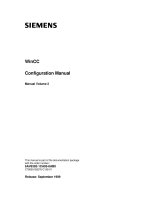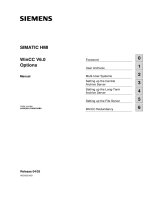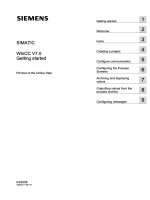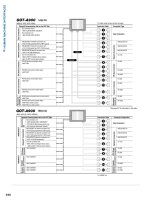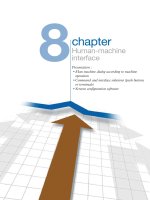SIEMENS SIMATIC win CC Human Machine Interface
Bạn đang xem bản rút gọn của tài liệu. Xem và tải ngay bản đầy đủ của tài liệu tại đây (2.83 MB, 468 trang )
Volume 1
Preface
Manual
Volume 1 / 2
2
3
WinCC Explorer
4
Channels
WinCC
System Overview
Authorization
SIMATIC HMI
1
5
Report Designer
6
User Administrator
7
Volume 2
Graphics Designer
Alarm Logging
11
Global Script
12
Cross Reference
C79000-G8276-C159-01
10
Text Library
Edition August 1999
9
Tag Logging
This manual is part of the
documentation package with the
order number: 6AV6392-1XA05-0AB0
8
13
®
®
®
®
®
WinCC , SIMATIC , SIMATIC NET , SINEC and STEP are Siemens registered trademarks.
All other product and system names in this manual are (registered) trademarks of their respective owners and
must be treated accordingly.
(The reproduction, transmission or use of this document or its
contents is not permitted without express written authority.
Offenders will be liable for damages. All rights, including rights
created by patent grant or registration of a utility model or
design, are reserved.)
(We have checked the contents of this manual for agreement
with the hardware and software described. Since deviations
cannot be precluded entirely, we cannot guarantee full
agreement. However, the data in this manual are reviewed
regularly and any necessary corrections included in subsequent
editions. Suggestions for improvement are welcomed.)
© Siemens AG 1994 - 1999 All rights reserved
Technical data subject to change
C79000-G8276-C159
Printed in the Federal Republic of Germany
Siemens Aktiengesellschaft
Volume 1
Preface
Manual
Volume 1 / 2
2
3
WinCC Explorer
4
Channels
WinCC
System Overview
Authorization
SIMATIC HMI
1
5
Report Designer
6
User Administrator
7
Volume 2
Graphics Designer
Alarm Logging
11
Global Script
12
Cross Reference
C79000-G8276-C159-01
10
Text Library
Edition August 1999
9
Tag Logging
This manual is part of the
documentation package with the
order number: 6AV6392-1XA05-0AB0
8
13
®
®
®
®
®
WinCC , SIMATIC , SIMATIC NET , SINEC and STEP are Siemens registered trademarks.
All other product and system names in this manual are (registered) trademarks of their respective owners and
must be treated accordingly.
(The reproduction, transmission or use of this document or its
contents is not permitted without express written authority.
Offenders will be liable for damages. All rights, including rights
created by patent grant or registration of a utility model or
design, are reserved.)
(We have checked the contents of this manual for agreement
with the hardware and software described. Since deviations
cannot be precluded entirely, we cannot guarantee full
agreement. However, the data in this manual are reviewed
regularly and any necessary corrections included in subsequent
editions. Suggestions for improvement are welcomed.)
© Siemens AG 1994 - 1999 All rights reserved
Technical data subject to change
C79000-G8276-C159
Printed in the Federal Republic of Germany
Siemens Aktiengesellschaft
08.99
Preface
Preface
Purpose
The WinCC User Guideđ describes:
ã the structure and function of WinCC and its components
• how to set up system-specific WinCC projects
• how to use WinCC at runtime
The User Guide is for WinCC V5.
Position within the Information Environment
The User Guide is part of the documentation on SIMATIC® HMI®. All the documentation
on WinCC is listed below.
Installation
Basics
Getting Started
WinCC Basic
Documentation
Vols. 1 and 2
Options
User Archives
Redundancy
Client Server
Pro Agent
Options in
Process
Control
Basic Process
Control
Process Control
Runtime
Development
Support
Open
Developers
Kit
Channel
Developers
Kit
WinCC Manual
C79000-G8276-C159-01
Configuration
Manual
Communication
Manual
Channel
Descriptions
i
Preface
08.99
Documentation
Contents
Getting Started
Uses a configuration example to show beginners how to proceed step
by step through a project, and introduces WinCC’s overall
functionality.
WinCC V5
Supplies information
Volume 1:
System Overview
Software Protection
ControlCenter
Server Data
Channels
Report Designer
User Administrator
• on interrelationships in WinCC
• on how software protection works
• on the structure, method of operation and use of WinCC Explorer
• on variables and variable groups
• on communication between WinCC and the process
• on creating and editing layouts for printing in Report Designer
• on assigning user rights in User Administrator
Volume 2:
Graphics Designer
Alarm Logging
Tag Logging
Text Library
Global Scripts
CrossReference
• on generating process maps in Graphics Designer
• on configuring, processing and archiving messages in Alarm
Logging
• on configuring, processing and archiving measured values in Tag
Logging
• on configuring multiple-language texts in Text Library
• on compiling C functions and actions in Global Script
• on generating lists of cross-references with Cross Reference
Configuration
Manual
Supplies information
Volumes 1, 2 and 3
• on special aspects of configuring
• on configuring in WinCC, with examples for illustration
• on the development environment for scripts, C functions and
actions (C course)
• on the graphics objects in Global Library
Communication
Manual
Volumes 1 and 2
Supplies information
• on links to SIMATIC via PROFIBUS, Industrial Ethernet and
OPC
• on communication drivers and how they are configured, using
examples for general links by way of illustration
• on special aspects of configuring
Channel
descriptions
Supply information for communication drivers
• on addressing variables in the automation system
• on parameterizing the communication partners
ii
WinCC Manual
C79000-G8276-C159-01
08.99
Preface
Documentation
Contents
WinCC Options
Supplies information on the options
User Archives
• User Archives: creating and using user archives
Client Server
• Client-Server: structure and use of WinCC in a client/server
system
Redundancy
• Redundancy: structure and use of redundant systems
ProAgent
Supplies information on the ProAgent option (process diagnosis)
• How to configure system-specific process diagnosis
• How to trace process errors and identify their causes
Basic Process
Control
Supplies information on the process-control options of WinCC
• Storage
• Picture Tree Manager
• Split Screen Manager
• Chipcard
• Lifebeat Monitoring
• Video
• Time Synchronization
Process Control
Runtime
Supplies information on the process-control options of WinCC
Open Developers
Kit
Explains programmers how to use WinCC’s API functions and how
to access the data
• Operation at runtime
Channel Developers Explains how to develop communication drivers for connecting
Kit
WinCC to any target system
WinCC Manual
C79000-G8276-C159-01
iii
Preface
08.99
Additional Support
Please do not hesitate to contact use if you encounter problems in operation. Call + 49 911
895-7000 if you need assistance in solving problems. Remember to have the software ID
number at hand to streamline the process: this number is on the software product card.
Lost or defective authorization can be "repaired" on the phone by our Customer Support.
The number to dial is + 49 911 895-7200.
Information about SIMATIC Products
SIMATIC Customer Support offers you wide-ranging additional information on SIMATIC
products by way of its online services:
• You can obtain general up-to-date information
- on the Internet at />- from the fax polling no. + 49 8765 93 02 77 95 00
• Up-to-date product information and downloads which may be of assistance during
operation:
- on the Internet at />- from the Bulletin Board System in Nuremberg (SIMATIC Customer Support
Mailbox): the number to dial is + 49 911 895-7100.
To dial into our mailbox, use a modem with a maximum baud rate that does not
exceed 28,800 bps (i.e. up to V.34) and set its parameters to 8, N, 1, ANSI or dial
yourself in via ISDN (x.75, 64 Kbit).
iv
WinCC Manual
C79000-G8276-C159-01
Volume 1
Preface
Manual
Volume 1 / 2
2
3
WinCC Explorer
4
Channels
WinCC
System Overview
Authorization
SIMATIC HMI
1
5
Report Designer
6
User Administrator
7
Volume 2
Graphics Designer
Alarm Logging
11
Global Script
12
Cross Reference
C79000-G8276-C159-01
10
Text Library
Edition August 1999
9
Tag Logging
This manual is part of the
documentation package with the
order number: 6AV6392-1XA05-0AB0
8
13
®
®
®
®
®
WinCC , SIMATIC , SIMATIC NET , SINEC and STEP are Siemens registered trademarks.
All other product and system names in this manual are (registered) trademarks of their respective owners and
must be treated accordingly.
(The reproduction, transmission or use of this document or its
contents is not permitted without express written authority.
Offenders will be liable for damages. All rights, including rights
created by patent grant or registration of a utility model or
design, are reserved.)
(We have checked the contents of this manual for agreement
with the hardware and software described. Since deviations
cannot be precluded entirely, we cannot guarantee full
agreement. However, the data in this manual are reviewed
regularly and any necessary corrections included in subsequent
editions. Suggestions for improvement are welcomed.)
© Siemens AG 1994 - 1999 All rights reserved
Technical data subject to change
C79000-G8276-C159
Printed in the Federal Republic of Germany
Siemens Aktiengesellschaft
Table of Contents
1
System Overview .................................................................................. 1-1
1.1
1.1.1
1.1.2
1.2
1.2.1
1.2.1.1
1.2.1.2
1.2.1.3
1.2.2
1.2.2.1
1.2.2.2
1.2.2.3
1.2.2.4
1.2.3
1.2.4
1.2.5
1.3
1.4
1.5
Installing WinCC ............................................................................................ 1-5
Entries in the Operating System Start Menu................................................. 1-5
Entries in the Windows Explorer Pop-Up Menu ............................................ 1-6
Configuration with WinCC V5.0..................................................................... 1-6
Project Types................................................................................................. 1-6
Single-User Project ....................................................................................... 1-7
Multi-User Project .......................................................................................... 1-8
Multi-Client Project ........................................................................................ 1-9
Configuring Distributed Systems ................................................................. 1-11
Packages for Multi-Client Projects .............................................................. 1-13
Server Configuration ................................................................................... 1-13
Multi-Client Configuration ............................................................................ 1-14
Configuration Example ................................................................................ 1-23
Configuring Pictures .................................................................................... 1-25
Configuring Messages................................................................................. 1-26
Visualizing Process Data............................................................................. 1-27
Project Documentation ................................................................................ 1-28
Integrating WinCC and STEP 7................................................................... 1-33
System Properties ....................................................................................... 1-38
WinCC Manual
C79000-G8276-C159-01
i
Table of Contents
ii
08.99
WinCC Manual
C79000-G8276-C159-01
08.99
System Overview
1 System Overview
WinCC - the interface between man and machine
WinCC is an industry- and technology-neutral system for solving visualization- and
controls-related tasks in production and process automation. It offers function modules for
the display of graphics, providing messages, archiving, and reporting which are suitable for
use in industry. Its high-performance process coupling, fast picture updating, and reliable
data archiving ensure high availability.
In addition to these system functions, WinCC provides open interfaces for user solutions.
This makes it possible to integrate WinCC into complex, company-wide automation
solutions. Archive data access via ODBC and SQL, as well as the linking of objects and
documents via OLE2.0 and ActiveX Controls, are integrated. These mechanisms make
WinCC a competent, communicative partner in the Windows world.
The foundation for WinCC is the Windows NT 32-bit operating system. Windows NT
features preemptive multitasking, which ensures fast reactions to process events and
provides a great deal of protection against data loss. Windows NT also offers functions
which focus on safety. WinCC software is itself a 32-bit application which was developed
using modern, object-oriented software programming techniques.
If WinCC is started via the Start Menu, the WinCC Explorer is opened first. From here, the
various editors can be accessed in which the various specialized tasks of a given operating
and monitoring system are performed.
The WinCC Editors
Graphics Designer
The Graphics Designer is a vector-oriented drawing program for creating process pictures.
Numerous graphic objects, which are contained in an object and styles palette, can also be
used to create complex process pictures. Dynamics can be added to individual graphic
objects by means of action programming. Wizards provide support by automatically
generating frequently used dynamics and linking them to objects. You can store your own
graphic objects in a library.
Alarm Logging
Alarm Logging provides displays and operating options for acquiring and archiving results.
You can freely select the message blocks, the message classes, the message type, the
message display, and the report. The System Wizard and the configuration dialogs provide
support during configuration. To display messages in runtime, the Alarm Control which is
contained in the object palette of the Graphics Designer is used.
Tag Logging
Tag Logging is used for acquiring data from running processes and for preparing them for
display and archiving. The data formats of the archives and the acquisition and archiving
timers can be freely selected. The display of the process values is made via the WinCC
Online Trend and Table Controls, which display the data in trend and table form,
respectively.
WinCC Manual
C79000-G8276-C159-01
1-1
System Overview
08.99
Report Designer
The Report Designer is an integrated reporting system for timer- or event-controlled
documentation of messages, operations, archive contents, and current or archived data in
the form of user reports or project documentation in freely selectable layouts. It provides a
comfortable user interface with tool and graphic palettes and supports the various report
types. Various standard system layouts and print jobs are available.
Global Script
Global Script is the generic term for C functions and actions which, depending on type, can
be used within a given project or within numerous projects. Scripts are used to configure
actions to objects. They are processed using a system-internal C compiler. Global Script
actions are used at runtime in process execution. Their execution is initiated by a trigger.
Text Library
In the Text Library, you can edit texts which are used in runtime by the various modules.
The foreign language output texts are defined in the Text Library for the configured texts.
These are then output in the selected runtime language.
User Administrator
The User Administrator is used for allocating and controlling access authorizations of the
users for the individual configuration- and runtime-system editors. When a user is set up,
the access rights for the WinCC functions are set and individually assigned to the respective
user. Up to 999 different authorization can be allocated. User authorizations can be
allocated at system runtime.
Cross Reference
Cross Reference is used to find and display all points of use for objects, e.g tags, pictures,
and functions. With the "Linking" function tag names can be changed without causing
inconsistencies in the configuration.
WinCC Basic Options
Client Server
With its client-server functionality, WinCC can be used to operate several coordinated
operating and monitoring stations in a common interconnection with networked automation
systems. Up to 64 subscribers can theoretically be integrated in a single project.
Redundancy
WinCC Redundancy offers the possibility to operate two coupled server-PCs in parallel so
that they can monitor one another. Should one of the two server computers fail, the second
server assumes control of the entire system. After the server which failed is brought back
into service, the contents of all message and process archives are copied to the server which
was out of service.
User Archives
WinCC User Archives is a database system which the user can configure himself. Data
from technical processes can in this way be continuously stored on a server PC and
displayed online in runtime. Moreover, recipes and setpoint assignments for the connected
controls can be stored in the User Archives and passed on to the controls as necessary.
1-2
WinCC Manual
C79000-G8276-C159-01
08.99
System Overview
WinCC Process Control Options
Storage
The storage functions support the automatic swapping of data from the hard disk to longterm data media as well as the deleting of data on the hard disk.
Picture Tree Manager
The Picture Tree Manager is used to manage a hierarchy of systems, subsystems, function
names, and Graphics Designer pictures.
Time Synchronization
Time Synchronization is a function for systems with SINEC L2/L2R bus systems. Here,
one WinCC operator station acts as the active time master and controls the synchronization
of all other operator stations and automation systems connected to the system bus with the
current time. This makes it possible to chronologically order messages for the entire
system.
Lifebeat Monitoring
Lifebeat Monitoring is used to constantly monitor the individual systems (operator station
and automation system) and visualizes the results as screen displays in the runtime system,
automatically triggers the horn component, and generates the automation system messages.
Base Data
Base Data is used for configuring the basic WinCC data by means of Wizards.
Split Screen Wizard
The Split Screen Wizard is a component of the Split Screen Manager. This is used for
configuring and initializing the monitor and screen settings for the current WinCC project.
You should perform this initialization immediately after creating a project, as other
applications (runtime, group display, etc.) access these data.
Alarm Logging Wizard
The Alarm Logging Wizard is used for configuring and initializing the message window,
messages, message classes and systems of the automation system messages, and the horn
signalling device for the current WinCC project.
WinCC Manual
C79000-G8276-C159-01
1-3
System Overview
08.99
Communication between WinCC and the control unit
The following connections are available for the communication between WinCC and the
various controls.
Communication types in combination with SIMATIC S5
Á serial via programming interface (AS511 protocol)
Á serial via 3964R (RK512 protocol)
Á Ethernet layer 4 (via data handling blocks)
Á Ethernet TF (technological functions)
Á S5-PMC Ethernet (PMC communication)
Option
Á S5-PMC Profibus (PMC communication)
Option
Á S5-Profibus-FDL
Option
Communication types in combination with SIMATIC S7
Á MPI interface (S7 protocol)
Á PROFIBUS (S7 protocol)
Á Industrial Ethernet (S7 protocol)
Á TCP/IP
Á SLOT PLC
Á S7-PMC PROFIBUS (PMC communication)
Mixed operation SIMATIC S5 / S7
SIMATIC S5 and SIMATIC S7 controls can be connected in parallel in the same network
and exchange data with WinCC. SIMATIC S7 uses only the S7 protocol.
Communication with other controls
Á Manufacturer-independent
Option
Á AEG Modicon
Modbus serial
Option
Á Allen Bradley
DF1 serial
Data Highway
Data Highway+
Highway 485
Option
Option
Option
Option
Á GE Fanuc
1-4
Profibus FMS/DP
SNP/SNPX protocol
Option
WinCC Manual
C79000-G8276-C159-01
08.99
System Overview
1.1 Installing WinCC
1.1.1 Entries in the Operating System Start Menu
Upon installation of WinCC, several links to auxiliary programs are established in the
\SIMATIC\WinCC folder of the Start Menu.
Channel Diagnosis
Use WinCC "Channel Diagnosis" to obtain an overview of the status of the configured
channels and their links to the PLC.
WinCC - Project Duplicator
Use the WinCC Project Duplicator to duplicate a completed project. In combination with
the WinCC Redundancy option, the Project Duplicator is used to create functionally
identical projects.
Note
Additional information about the WinCC - Project Duplicator can be found in the
Redundancy manual.
WinCC - Project Switcher
The "WinCC Project Switcher" is used to switch-over projects of the client between two
redundant servers. In the event of a server failure, a switch-over to the redundant partner
server can be performed automatically. As a result, the client is not affected by a server
failure, as its project is taken over by the partner server.
Note
The configuration of the WinCC Project Switcher of V4.02 cannot be used for
V5.0. The Project Switcher must be configured again for V5.0.
Additional information about the WinCC - Project Switcher can be found in the
Redundancy manual.
WinCC-Scope
WinCC Scope supports you during WinCC diagnostic work. WinCC Scope is based on
Internet technology. An Internet browser, such as the Internet Explorer or the Netscape
Navigator, is required to start the "CCDiagAgent" diagnosis program. The TCP/IP protocol
must also be installed.
Windows Control Center
The WinCC Explorer is started by activating the "Windows Control Center" button.
WinCC Manual
C79000-G8276-C159-01
1-5
System Overview
08.99
1.1.2 Entries in the Windows Explorer Pop-Up Menu
Upon installation of WinCC, the following additional entries are added to the Windows
Explorer pop-up menu "File" "New":
Entries
Description
WinCC Document
Creates a file named "New WinCC-Document.MCP" in
the selected folder.
WinCC.Graphics.Document
Creates a file named "New
WinCC.Graphics.Document.pdl" in the selected folder.
WinCC CrossRef Document
Creates a file named "New WinCC CrossRef
Document.xfc" in the selected folder.
1.2 Configuration with WinCC V5.0
1.2.1 Project Types
The following terms are used in the descriptions of the individual project types.
Term
Client
A client that has been permanently assigned to a server in a multiuser project. The client can be used in a multi-user project or in a
distributed system.
Multi-Client
As of WinCC V5.0, a multi-client can access data on up to 6
servers. The multi-client is not a component of this server project.
Server
Server of a multi-user project with client and multi-clients. A
redundant server pair can also represent a server.
Functional
Distribution
Various servers take on different tasks in specific areas of the
process.
Technological
Distribution
1-6
Meaning
Different servers take on all necessary area-specific tasks.
WinCC Manual
C79000-G8276-C159-01
08.99
System Overview
1.2.1.1 Single-User Project
A single-user project is a single-operator terminal. The configuration, operation, as well as
the connection to the process bus and storing of project data, are performed on this
computer.
WinCC Visualization
(optional)
Database
WinCC Server component
WinCC - Server
Field-Bus
AS
WinCC Manual
C79000-G8276-C159-01
AS
AS
1-7
System Overview
08.99
1.2.1.2 Multi-User Project
A multi-user project is characterized by multiple clients and one server, all of which work
with the same project. Here, up to 16 clients can access a single server. Configuration can
take place on the server or on any of the clients. Project data such as pictures, tags, and
archives are preferably stored on the server and are made available to all clients. The
connection to the process bus and the processing of the process data are implemented by the
server. Runtime is usually operated from the clients.
WinCCWinCCVisualization
Visualization
(optional)
WinCCVisualization
Access to project data
Access to project data
WinCC-
WinCCDatabase
WinCC-
WinCC-Server
Client
Client
Component
ServerComponent
Component
WinCC-Client 1
WinCC-Client 2
Field-Bus
AS
1-8
AS
WinCC Manual
C79000-G8276-C159-01
08.99
System Overview
1.2.1.3 Multi-Client Project
Each multi-client project is a project type that can access the data of multiple servers. Each
multi-client and the associated servers have their own project. The configuration of the
server project is performed on the server or on the clients; the configuration of the multiclient project is performed on the multi-client.
A server can be accessed by up to 16 clients or multi-clients. In runtime, a multi-client can
access up to 6 servers. This means that, for example, the data from 6 different servers can
be visualized on one picture of the multi-client. The following picture illustrates an
example of how the various servers appear on the multi-client during runtime.
WinCC-Multi-Client
WinCC
Visualization
WinCCComponent
WinCC-Server
Component
WinCC-Server
WinCC-Server
Component
WinCC-Server
WinCC-Server
Component
WinCC-Server
Technological Distribution:
The various referenced servers perform the same tasks, i.e. message archiving,
measurement value archiving, and process data linking. However, each server
considers a different logical system section. In an application structured around
subsystems, the servers are connected to different PLCs independently of each other.
In PCS7 the form of logical distribution is primarily used.
Note
It is recommended to structure systems in accordance with technological distribution; the
functional distribution is created only by means of a specific configuration.
WinCC Manual
C79000-G8276-C159-01
1-9
System Overview
08.99
Client
of Server1
Multi-Client
Client
with view to
Server1 and Server2
of Server2
Database
Server1
Server2
Database
Database
Functional Distribution:
The various referenced servers in a multi-client project perform various tasks. For
example, one WinCC server performs the archiving, another one the message
processing and a third one the process data linking.
Note
Tags required for the server operation must also be configured on the message and archive
servers. Message and archive servers do not access the data server to determine the process
data.
1-10
WinCC Manual
C79000-G8276-C159-01
08.99
System Overview
1.2.2 Configuring Distributed Systems
Distributed systems can be created as of Version 5.0. This means that 2 to 6 servers can be
operated and monitored by one client, the so-called multi-client.
Here, distinctions can be drawn between three fundamentally different types of operation.
1.
Multi-client operation of all server pictures from an overview picture or, for PCS7,
from an overview area (no picture change required).
2.
Integration of single/multiple pictures of single/multiple servers into one picture
(picture-in-picture method).
3.
Creation of pictures containing tags of different servers.
Level 1
The following steps are required:
• Generate all packages of the participating servers and load them onto the multi-clients.
• For WinCC (native): Make the start pictures of the server projects selectable from an
overview picture.
• For WinCC in the PCS7 environment, proceed as follows:
The following steps illustrate the configuration of a distributed system in the PCS7
environment.
1.
Create a server project using the Split Screen Wizard and the Alarm Logging Wizard.
2.
Configure the picture hierarchy using the Picture Tree Manager.
3.
Configure the user authorizations in the User Administrator.
4.
Generate the packages on the servers.
5.
Create a multi-client project using the Split Screen Wizard.
6.
Load the packages.
7.
Configure the Life Beat Monitoring functions on the multi-client.
8.
Configure the user authorizations in the User Administrator of the multi-client.
You can now display all server pictures on the multi-client and navigate among them as
usual.
Note
If all servers are accessed via multi-clients, it is possible to disconnect the regular "V4.0
clients". The freed PCs can be used for other purposes.
WinCC Manual
C79000-G8276-C159-01
1-11
System Overview
08.99
Level 2
Level 2 finds its application mainly in the creation of overview pictures. The layout must be
designed in such a way that multiple pictures can be displayed simultaneously. Pictures
from previous WinCC versions can be reused. (see Chapter 1.2.2.3)
Multi-Client
Screen window
Screen window
Server1:BS1
Server2:BS2
Picture: Picture-In-Picture Method
Level 3
Level 3 finds its application mainly in the creation of pictures (also overview pictures), in
which data of several servers are to be displayed, but without using the picture-in-picture
method. The picture is directly connected to the tags of the servers. (see Chapter 1.2.2.3)
Multi-Client
I/O - Field
“Server1:Tag”
WinCCAlarm Control
“Server1:Tag”
“Server2:Tag”
“Server1:Tag”
WinCCTrend/Table Control “Server2:Tag”
Basic screen
Picture: Picture configuration with connection to different servers
1-12
WinCC Manual
C79000-G8276-C159-01
08.99
System Overview
1.2.2.1 Packages for Multi-Client Projects
In order to be able to access the relevant data on a server in a multi-client project in
runtime, packages are used. The packages contain symbolic names of project-relevant data
such as pictures, tags, messages, and archives. Packages must be generated on the servers
and be loaded onto the multi-client. The generation and loading can be performed in
runtime as well as in the configuration system.
After changing the configuration data of server projects, the packages must be generated
again. The "Update" function updates the packages on the multi-client.
Note
It is the user’s responsibility to update the local packages.
Multi-Client
Packages of Server 1
and Server 2 will be
copied into the project
database of the MultiClient
Server 1
Server
Data of
Database
Server 1
(package)
Multi-Client
Project
Server 2
Data of
Server 2
(package)
Server
Database
Data of
Server 3
(package)
1.2.2.2 Server Configuration
A multi-user project with or without clients is created on the server. A server project cannot
be configured from a multi-client. Also, the activation and deactivation of server projects
cannot be performed from a multi-client. These types of tasks can be performed by one of
the clients integrated in the distributed system.
WinCC Manual
C79000-G8276-C159-01
1-13


